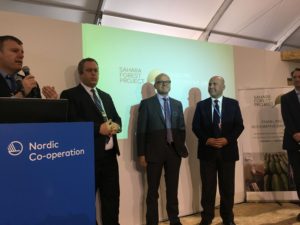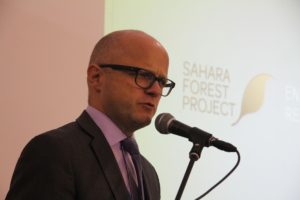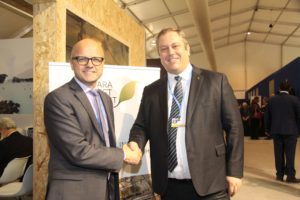UN Climate Summit COP22, Marrakech
-This is a day of celebration for those of us who are working to find profitable and sustainable solutions to increase food, water and energy security in desert areas. With this positive message we are building larger than previously planned!
That was the message from an enthusiastic Joakim Hauge, CEO of the Sahara Forest Project when Norway’s Climate and Environment Minister Vidar Helgesen announced that his ministry contributes with an additional 600.000 euros to the expansion of the Sahara Forest Project in Jordan.
The announcement came on the first day during the high level UN Climate Summit in Marrakech, where Minister Helgesen attended an event about green restorative growth in Jordan along with Eng. Ziad Jibril Sabra advisor to the Jordanian Energy Minister, Executive Director Rasmi Hamzeh from Jordan’s Renewable Energy & Energy Efficiency Fund and Jerome Mounsey, Senior Climate Policy Officer in the European Commission.
-The Sahara Forest Project is an exciting effort to meet fundamental challenges the world is facing the coming decades, the Norwegian Climate and Environment Minister Vidar Helgesen said.
The Minister said he was encouraged about the previous results from the pilot phase, and stressed the need for use land in order to produce more food and more energy without increase deforestation. Helgesen was eagerly supporting the idea to capture carbon from the atmosphere and store it in plants and soil in areas of the world that is not in use today. The Minister conveyed his hope for a quick deployment of both technology and business model.
Sahara Forest Project CEO Joakim Hauge was grateful for the support for making the Aqaba facility larger than originally planned.
-This new financial contribution from the Norwegian Climate and Environment Ministry means a significant increase in our level of ambition for Jordan, says Hauge.
Norwegian Minister Vidar Helgesen and Joakim Hauge of SFP
The Sahara Forest Project revegetates desert landscape through the production of vegetables, fresh water, biofuels and renewable energy. The unique solution combines existing verified environmental technologies in a new way.
-All about the synergies
The Sahara Forest Project produces products in high global demand, while at the same time store CO2 from the atmosphere with new outdoor vegetation in the previously barren areas.
-The UN Climate Panel IPCC and global climate ministers stress the need for carbon negative solutions like The Sahara Forest Project to combat climate change. The facility that we are now realizing in Jordan will be a concrete example of how climate solutions and new restorative growth can go hand in hand, says Hauge
-Important Step towards commercial operation
After a successful pilot project in Qatar, The Sahara Forest Project will now triple its next plant in the Jordanian port city of Aqaba located close to the borders of Israel and Saudi Arabia.
The new facility will be built on an area the size of four football pitches, and include two saltwater-cooled greenhouses that use seawater to provide perfect growing conditions for vegetables all year round in the desert. It will use solar energy and outdoor vegetation zones which will grow food and plants that will combat desertification and store CO2.
The Sahara Forest Project is now taking an important step towards the next phase in Jordan plan: A 20-hectare commercially operated plant.
– This is an important step towards commercial operation. With the larger facility that the Norwegian government now gives most valuable financial assistance to realize, we will start producing vegetables and products at a level that will create a lot of interest from investors and business, says Hauge.
-Will produce 10.000 liters of freshwater
Only four countries in the world is worse off than Jordan in terms of access to fresh water. To develop agricultural solutions that do not erode the scarce freshwater resources is an important requirement in the country.
-Jordan is a country in a region that is thirsty for this kind of future-oriented industries which gives hope for the population. We are very happy and proud for the commitment we meet from the Jordanian royal family, the Jordanian authorities and the Jordanian people, says Joakim Hauge.
He stressed that the Sahara Forest Project is not going to use the Jordan’s freshwater to their business.
-The Sahara Forest Project uses what we have enough of to produce what we need more of. We will build a desalination plant in which saltwater will be used produce 10,000 liters of fresh water every day, says Hauge.
Hauge concludes with the importance of getting solutions like the Sahara Forest Project rolled out on a large scale. -All arid areas with access to saltwater may in the future help to ease the pressure from other land are where you often see food and energy production in conflict with climate and environmental concerns, says Hauge.
Informal meeting with SFP funding partner EU Climate Commissioner Miguel Arias Cañete.
International partner portfolio
The Norwegian Climate and Environment Ministry is the largest financial contributor to the Jordan Launch Station, with a total of approx. 1,9 million Euros. In addition, the project is supported financially by the European Commission, the US Development Agency USAID, Grieg Foundation and Yara International.
Including investments from the Sahara Forest Project AS, the budget for the Jordan Launch Station is now increased to 3,3 million Euros.
For more information:
Magnus Borgen, Head of Communications The Sahara Forest Project, Tel: +47 977 28 476, magnus@saharaforestproject.com




